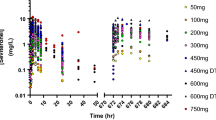Summary
17α-ethynyl-5α-androstane-3α, 17β-diol (HE3235, Apoptone) is an orally bioavailable synthetic analogue of 3β-androstanediol, that is active in rodent models of prostate and breast cancer, and is in Phase IIa clinical trials for the treatment of early- and late-stage prostate cancer. In preparation for clinical studies, nuclear hormone receptor and P450 interactions for HE3235 and major metabolites were characterized in vitro, and pharmacokinetics and metabolite profiles were studied in rodents, dogs, and monkeys. Four-week safety studies conducted in rats and dogs indicated a substantial margin of safety for clinical use, and no evidence of electrocardiographic or neurological effects, although anorexia, thrombocytopenia, and hypokalemia were identified as potentially dose-limiting toxicities at superpharmacological exposures. Pharmacokinetics and drug metabolism have been studied in prostate cancer patients.




Similar content being viewed by others
References
Jemal A, Siegel R, Ward E, Murray T, Xu J, Thun MJ (2007) Cancer statistics, 2007. CA Cancer J Clin 57:43–66
Halabi S, Small EJ, Kantoff PW, Kattan MW, Kaplan EB, Dawson NA, Levine EG, Blumenstein BA, Vogelzang NJ (2003) Prognostic model for predicting survival in men with hormone-refractory metastatic prostate cancer. J Clin Oncol 21:1232–1237
Martin C, Ross M, Chapman KE, Andrew R, Bollina P, Seckl JR, Habib FK (2004) CYP7B generates a selective estrogen receptor beta agonist in human prostate. J Clin Endocrinol Metab 89:2928–2935
Bauman DR, Steckelbroeck S, Peehl DM, Penning TM (2006) Transcript profiling of the androgen signal in normal prostate, benign prostatic hyperplasia, and prostate cancer. Endocrinology 147:5806–5816
Koreckij TD, Trauger RJ, Montgomery RB, Pitts TE, Coleman I, Nguyen H, Reading CL, Nelson PS, Vessella RL, Corey E (2009) HE3235 inhibits growth of castration-resistant prostate cancer. Neoplasia 11:1216–1225
Wang T, Villegas S, Huang Y, White SK, Ahlem C, Lu M, Olefsky JM, Reading C, Frincke JM, Alleva D, Flores-Riveros J (2010) Amelioration of glucose intolerance by the synthetic androstene HE3286: link to inflammatory pathways. J Pharmacol Exp Ther 333:70–80
U. S. Department of Health and Human Services FaDA, Center for Drug Evaluation and Research (CDER), Center for Biologics evaluation and Research (CBER), Rockville, MD (2006) FDA guidance for industry, drug interaction studies—study design, data analysis, and implications for dosing and labeling
FDA Guidance for Industry (1997) Genotoxicity testing and data intrepretation for pharmaceuticals intended for human use, Rockville, MD.: U. S. Department of Health and Human Services, Food and Drug Administration, Center for Drug Evaluation and Research (CDER), ICH
Ames BN, McCann J, Yamasaki E (1975) Methods for detecting carcinogens and mutagens with the Salmonella/mammalian-microsome mutagenicity test. Mutat Res 31:347–364
Maron DM, Ames BN (1983) Revised methods for the Salmonella mutagenicity test. Mutat Res 113:173–215
Green MH, Muriel WJ (1976) Mutagen testing using TRP+ reversion in Escherichia coli. Mutat Res 38:3–32
Venitt S, Parry J (eds) (1984) Mutagenicity testing: a practical approach. Washington, DC, Oxford
Evans HJ (1976) Cytological methods for detecting chemical mutagens. In: Hollaender A (ed) Chemical mutagens, principles and methods for their detection, Vol 4. Plenum Press, New York and London, pp 1–29
Galloway SM, Bloom AD, Resnick M, Margolin BH, Nakamura F, Archer P, Zeiger E (1985) Development of a standard protocol for in vitro cytogenetic testing with Chinese hamster ovary cells: comparison of results for 22 compounds in two laboratories. Environ Mutagen 7:1–51
Heddle JA (1973) A rapid in vivo test for chromosomal damage. Mutat Res 18:187–190
Schmid W (1975) The micronucleus test. Mutat Res 31:9–15
Hayashi M, Tice RR, MacGregor JT, Anderson D, Blakey DH, Kirsh-Volders M, Oleson FB Jr, Pacchierotti F, Romagna F, Shimada H et al (1994) In vivo rodent erythrocyte micronucleus assay. Mutat Res 312:293–304
Moser VC, McCormick JP, Creason JP, MacPhail RC (1988) Comparison of chlordimeform and carbaryl using a functional observational battery. Fundam Appl Toxicol 11:189–206
Moser VC, Ross JF (1996) Training video and reference manual for a functional observational battery. U.S. Environmental Protection Agency, Research Triangle Park, NC
Meyer OA, Tilson HA, Byrd WC, Riley MT (1979) A method for the routine assessment of fore- and hindlimb grip strength of rats and mice. Neurobehav Toxicol 1:233–236
Edwards PM, Parker VH (1977) A simple, sensitive, and objective method for early assessment of acrylamide neuropathy in rats. Toxicol Appl Pharmacol 40:589–591
Ankier SI (1974) New hot plate tests to quantify antinociceptive and narcotic antagonist activities. Eur J Pharmacol 27:1–4
Penning TM, Burczynski ME, Jez JM, Hung CF, Lin HK, Ma H, Moore M, Palackal N, Ratnam K (2000) Human 3alpha-hydroxysteroid dehydrogenase isoforms (AKR1C1-AKR1C4) of the aldo-keto reductase superfamily: functional plasticity and tissue distribution reveals roles in the inactivation and formation of male and female sex hormones. Biochem J 351:67–77
Mottino AD, Veggi LM, Wood M, Roman JM, Vore M (2003) Biliary secretion of glutathione in estradiol 17beta-D-glucuronide-induced cholestasis. J Pharmacol Exp Ther 307:306–313
Zoller AL, Kersh GJ (2006) Estrogen induces thymic atrophy by eliminating early thymic progenitors and inhibiting proliferation of beta-selected thymocytes. J Immunol 176:7371–7378
Trauger R, Corey E, Bell D, White S, Garsd A, Stickney D, Reading C, Frincke J (2009) Inhibition of androstenediol-dependent LNCaP tumour growth by 17alpha-ethynyl-5alpha-androstane-3alpha, 17beta-diol (HE3235). Br J Cancer 100:1068–1072
Hennebert O, Montes M, Favre-Reguillon A, Chermette H, Ferroud C, Morfin R (2009) Epimerase activity of the human 11beta-hydroxysteroid dehydrogenase type 1 on 7-hydroxylated C19-steroids. J Steroid Biochem Mol Biol 114:57–63
Yamazaki H, Shimada T (1997) Progesterone and testosterone hydroxylation by cytochromes P450 2C19, 2C9, and 3A4 in human liver microsomes. Arch Biochem Biophys 346:161–169
Weihua Z, Lathe R, Warner M, Gustafsson JA (2002) An endocrine pathway in the prostate, ERbeta, AR, 5alpha-androstane-3beta, 17beta-diol, and CYP7B1, regulates prostate growth. Proc Natl Acad Sci USA 99:13589–13594
Georgiadis EI, Matzoros C, Aliferis C, Batrinos M (1992) Are adrenal and testicular androgen levels correlated? Horm Metab Res 24:488–491
Author information
Authors and Affiliations
Corresponding author
Rights and permissions
About this article
Cite this article
Ahlem, C., Kennedy, M., Page, T. et al. 17α-Alkynyl 3α, 17β-androstanediol non-clinical and clinical pharmacology, pharmacokinetics and metabolism. Invest New Drugs 30, 59–78 (2012). https://doi.org/10.1007/s10637-010-9517-0
Received:
Accepted:
Published:
Issue Date:
DOI: https://doi.org/10.1007/s10637-010-9517-0




